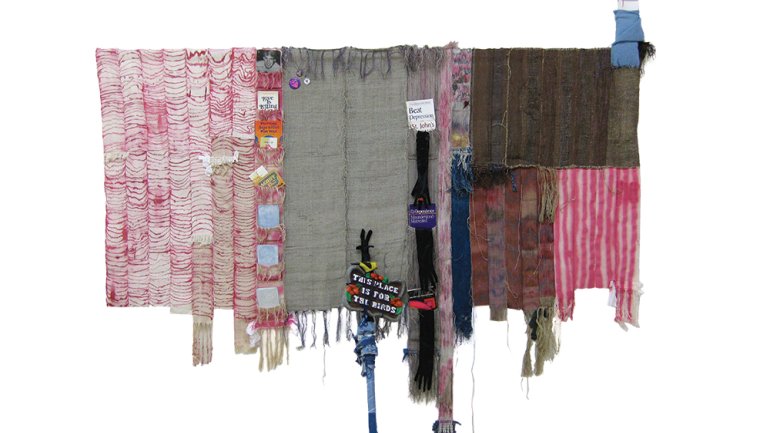Taking Skill Down a Peg
Taking Skill Down a Peg
A new book explores the power of 'sloppy craft.'
Finesse. Virtuosity. Polish. Some craft artists are deliberately flouting these ideals. Before you gasp, consider that this might be a good thing. That’s what Elaine Cheasley Paterson and Susan Surette suggest as editors of a new book, Sloppy Craft: Postdisciplinarity and the Crafts (Bloomsbury Academic). The book gathers a dozen essays from craft scholars and educators, who write about the “sloppy craft” aesthetic and the power that artists have discovered in it. Coined in 2007 by artist and educator Anne Wilson, the term refers to an approach that emphasizes concept over advanced skill, and process over refined product, calling into question revered traditional principles of craft.
We talked with Surette and Paterson about the possibilities of this unorthodox approach.
What are the possibilities of sloppy craft? Why do artists choose this approach?
Paterson: There are really interesting and diverse reasons why artists use this approach. Some of the concepts that sloppy craft has been used to address are: gender; ideas about skill, including how it relates to domestic life; labor, including controlled production, handwork, the apprenticeship system, and the amateur in relation to the professional; time; process; and performance.
Surette: Another reason that artists might adopt a sloppy approach is that it helps them break away from tightly skilled work and bring in a playfulness, an openness, creativity, and innovation.
Paterson: Trying to work sloppily on purpose can be a welcome challenge for artists. It’s very hard to make your body not do the fine work that it’s capable of doing and that you’ve been trained to do for so long.
Can you share a few examples of artists using a sloppy craft approach?
Paterson: We refer to Josh Faught as “the original sloppy crafter,” because Anne Wilson coined “sloppy craft” in response to his work. He works with fiber and employs many craft techniques, but his style resembles amateur making rather than fine craft.
Laurent Craste, whose work is featured on the cover of the book, is a highly skilled ceramist and makes exquisite objects, along the lines of Sèvres porcelain. At a certain point, he slams a crowbar or some other tool into his pieces and alters them completely. The instruments he uses are representative of industrial labor and manufacturing tools, as opposed to highly skilled porcelain making. So he’s breaking apart his initial skilled work and bringing in other notions of skill, through sloppiness.
Kent Monkman is a Canadian artist of Cree ancestry who works in a variety of mediums. In some pieces, he mashes up craft traditions and unexpected objects, as in Beaded Moccasins (2007), where he uses beadwork on a pair of strappy red platform sandals. Scholar Elizabeth Kalbfleisch addresses Monkman’s work within the context of prized practices in aboriginal art, such as basketry, weaving, blackware pottery, and fine beadwork. She looks at the culturally contingent view of craft and what the stakes are for someone working within those traditions. The difference between “skill” and “sloppy” is socially determined. Monkman is rejecting the boundaries, perhaps.
Surette: Maryhill Burgh Halls, in Glasgow, Scotland, a historic building that was renovated with input from the local community, is an example of how sloppy craft can be about building community. Folks from the town participated in workshops on everything from stained glass to stonemasonry, and some of their work was featured in the new building. The focus was on the process and the community rather than the finished product.
Can sloppy craft be taught? Is it a matter of stressing concept and playing down material skills?
Surette: It’s more complex than just stressing concept and de-emphasizing material skills. The relationship between skill and concept is different for each maker, and it’s determined by their personal needs and what they want to say. But concept is often emphasized over material skill at universities, which are in many cases downgrading or eliminating their skilled, material-based programs, such as textiles and ceramics. As a result, makers often aren’t learning skills; instead, they contract out for that work.
So students gravitate toward sloppy craft because they don’t have the skills to do what they want to do, they don’t have the time, or the education system doesn’t allow them to develop the highly refined skills. Sloppiness is a shortcut in this context. The challenge to educators, then, is to go beyond this go-to sloppiness and allow students to develop skills.
What’s the future of sloppy craft? How does skilled craftsmanship fit into the picture?
Paterson: The reverence for careful craftsmanship hasn’t disappeared, and sloppy craft and fine craft don’t preclude each other. Sloppy craft maybe draws attention to careful craftsmanship by virtue of its omission. We’ve simply shifted gears, and there are different ways of thinking. The key is to enjoy the innovations and improvisations that go along with sloppy craft practices and integrate these into a larger language of craft, while still appreciating a skillfully made object.
Surette: There is real personal power that comes from skillful work, and many people recognize the value of human labor, the energy that’s put into making, and the acquiring of knowledge that’s part of skillful work. That doesn’t go out of style.
Liz Logan is a Brooklyn freelance writer whose work has appeared in the New York Times and other publications.




